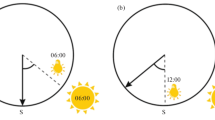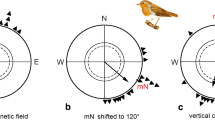Summary
A series of clock-shift experiments with young homing pigeons of various ages was performed to determine at what age they normally learn sun compass orientation. The response of untrained pigeons to shifting of their internal clock seems to depend on their age. When the clock-shifted birds were tested at an age of 11 weeks and younger, their departure bearings did not differ significantly from those of controls (Fig. 1, diagrams on the right); in tests with birds 12 weeks and older the characteristic deviation indicating the use of the sun compass was observed (Figs. 2 and 3). Birds that had participated in a short training program, however, used the sun compass at 8 weeks, the earliest age tested (Fig. 1, diagrams on the left). These findings show that the time of development of the sun compass strongly depends on flying experience. Within the first months of a bird's life, it seems to take place after the bird has been confronted with the need to orient, either spontaneously during extended exercise flights around its loft or imposed by training releases.
The departure bearings of the very young, inexperienced birds that did not rely on the sun compass, however, were already oriented homeward. This indicates that the ability to navigate develops independently of the sun compass, before the sun compass is learned.
Similar content being viewed by others
References
Batschelet E (1965) Statistical methods for the analysis of problems in animal orientation and certain biological rhythms. Am Inst Biol Sci, Washington, DC
Batschelet E (1972) Recent statistical methods for orientation data. In: Galler SR, Schmidt-Koenig K, Jacobs GJ, Belleville RE (eds) Animal orientation and navigation, NASA SP-262. US Gov Print Office, Washington DC, pp 61–93
Batschelet E (1978) Second-order statistical analysis of directions. In: Schmidt-Koenig K, Keeton WT (eds) Animal migration, navigation and homing, Springer, Berlin Heidelberg New York, pp 3–24
Keeton WT (1971a) Magnets interfere with pigeon homing. Proc Natl Acad Sci USA 68:102–106
Keeton WT (1971b) Remarks in a panel discussion: Unconventional theories of orientation. Ann NY Acad Sci 188:333–335
Keeton WT, Gobert A (1970) Orientation by untrained pigeons requires the sun. Proc Natl Acad Sci USA 65:853–856
Schmidt-Koenig K (1961) Die Sonne als Kompaß im Heim-Orientierungssystem der Brieftauben. Z Tierpsycholl 18:221–244
Wiltschko W, Wiltschko R, Keeton WT (1976) Effects of a “permanent” clock-shift on the orientation of young homing pigeons. Behav Ecol Sociobiol 1:229–243
Author information
Authors and Affiliations
Additional information
Dedicated to Prof. Dr. F.W. Merkel for his 70th birthday
Rights and permissions
About this article
Cite this article
Wiltschko, R., Wiltschko, W. The development of sun compass orientation in young homing pigeons. Behav Ecol Sociobiol 9, 135–141 (1981). https://doi.org/10.1007/BF00293584
Received:
Accepted:
Issue Date:
DOI: https://doi.org/10.1007/BF00293584




